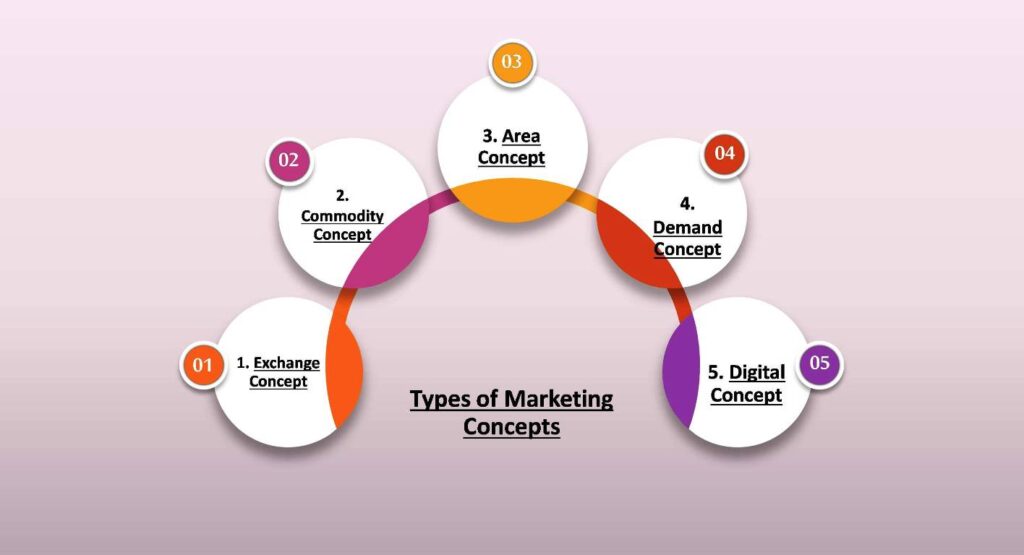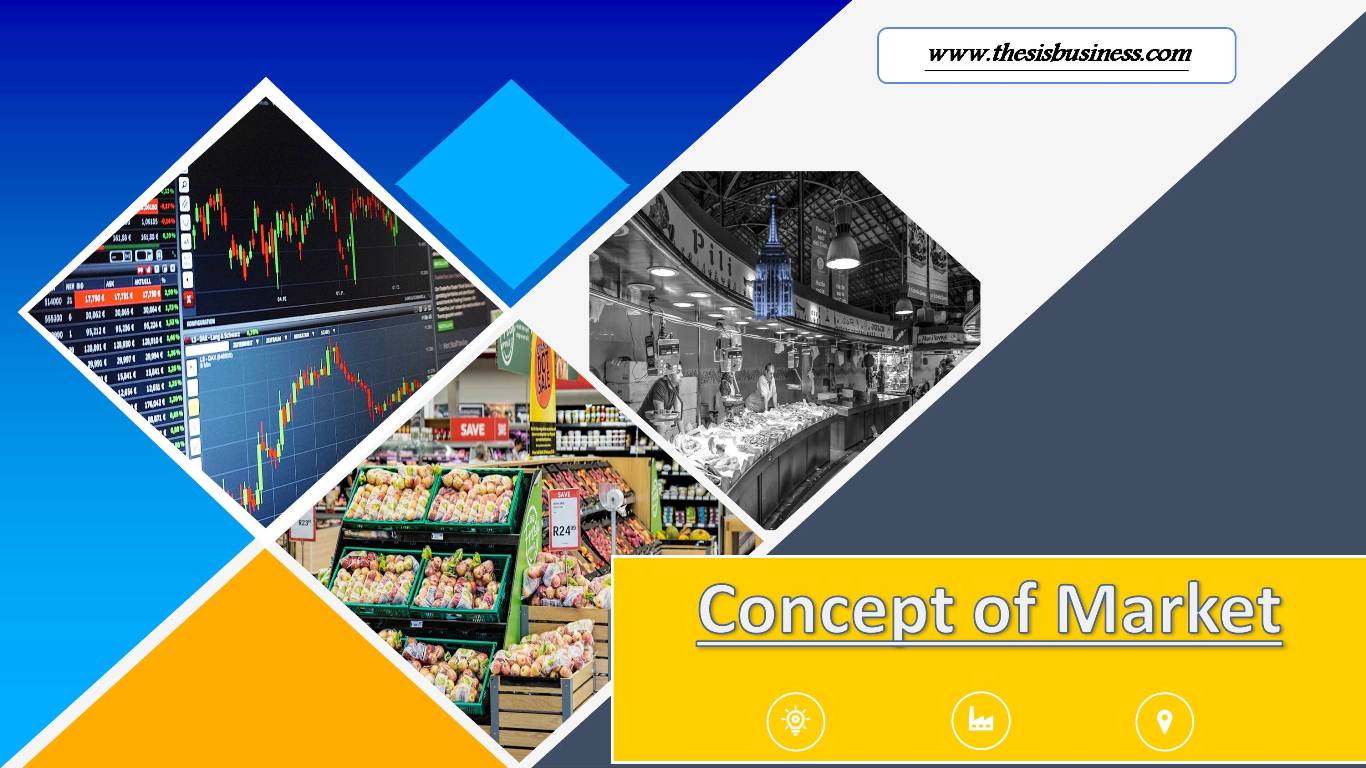Let us know – How many times you hear the word “Market” in your day-to-day life. We are sure- multiple times. But the market in a general sense and the market in management is quite different. Here is an in-depth article for those looking to explore the definition, features, types, and classification of marketing through the management angle.
Table of Contents
What is the Market?
The market is an English word, although it is derived from the Latin word “‘Marcatus.’ The meaning of that word denotes “A place where trading or transaction occurs.” Marketing is made from the market that defines the process.
Different Types of Marketing Concepts –

1. Exchange Concept
This concept stresses the fulfillment of required things without the involvement of cash. In the past, there was a barter system where buyer and seller exchanged needed items without cash involvement. The buyer needs milk, and the seller needs rice- So they both exchange among them.
Here, both buyer and seller exchange voluntarily, and the motives to earning get a back seat. Some scholars also call it the “Give and Take” concept.
Even the poorer class of people can survive in this type of market concept. Both the parties emphasize building relationships and equality of prices for the goods/services. Sellers Monopoly in any particular goods category hampers this market concept.
2. Commodity Concept
Here, more emphasis is given to the physical selling and purchasing of goods and services. Sellers and buyers interact with each other and exchange their needs. The buyer requires wheat, and the seller requires cash- So both sell/buy them on agreed terms.
3. Area Concept
The area concept is vast as it can cover all the other concepts in itself. The concept provides a base for the free interchange of goods and services in certain areas and depends on demand and supply rules. It does not require a direct connection between buyer and seller; instead, both remain connected through trust and do the agreed work.
4. Demand Concept
Demand is the most significant concept that determines the market to a certain extent. Do you wonder? Why products from some particular brands are available in your locality? It’s because of the product’s demand or a company is looking to create demand through consistent and over-supply.
Humans require unlimited things, and that cannot be satisfied. So when there is demand, companies create the market through the distribution channels, price reduction, ownership transfer, and other steps.
5. Digital Concept
This concept is new, but it has revolutionized the whole world. All of a sudden, more and more people are opting for digital channels for their goods and services purchasing, selling, exchanging, and others.
With the help of information technology, buyers and sellers interact on a platform or through digital means for doing the transactions. One can buy anything from their home by using digital devices. A seller sitting in the other corner of the world uses IT devices for selling products/services to another corner.
Google, Facebook, Apple, Amazon, and there are many examples of this concept. Buyer and seller do not remain connected physically; they still trust each other, and transactions happen.
Different Types of Market – Classification
This category is subdivided into five different categories:
1. Market Classification – Time-wise
Short period or temporary market:
It is also called the weekly or hourly market that is very prevalent in rural areas. Nearby sellers come to the market with their products and sell them to the buyers. Goods get sold, and the market gets disbursed for the next time.
Long-period or permanent market:
This is also called an urban market with high population density and purchasing power. The market remains open from early morning to midnight. Various items are sold here, and there could be different times for different shops.
2. Market Classification – Geographical Areawise
Local markets:
Mostly, daily-use products, including perishable items, are sold here. Please note, Your local market could be the regional market for someone else. So the local market is a place located in a small and nearby area.
Regional market:
When the local market becomes large, it is called a regional market. People from a city might consider their market as local; however, that could be a regional market for nearby villages.
National market:
It is also called the domestic market, where goods and services are sold nationwide. That also varies as there is no similarity in size between nations. Many states of India are larger than most of the European countries.
International market:
As the name itself denotes, here products and services are sold worldwide. Google, Toyota, Apple, LG, and others are in the international market.
3. Market Classification – Control-wise
Regulated market:
Can anyone sell jewelry by sitting roadside? No, why? Because- it’s a regulated trade. Government makes rules for that, and sellers are bound to abide by them. Regulated markets exist to contain the high price rise, stop illegal activities, and maintain the level playing field for all sellers.
Unregulated market:
Mostly daily use things, perishables items, and villages markets are unregulated. Anyone can enter the market and sell the products or services without prior permission from the regulator.
4. Market Classification – Volume-wise
Wholesale:
Here, big buyers and sellers interact for a large volume of trade. Prices are slightly lower as wholesalers further sell the goods to retailers with some profit margin.
Retail market:
In this market, the customer buys products or services for end-use. Customers become consumers, and retailers get direct contact with them.
5. Market Classification – Delivery-wise
Spot market:
Here, as soon as the money or transactions happen, delivery takes place. You buy a book and take it for yourself; that’s the spot market.
Future market:
Delivery takes place in future time based on the agreement or contract. The payment gets done at the time of sale or in the form of cash on delivery. It’s also called a postpaid service. Ecommerce purchases, postpaid mobile bills, car booking, and so on are examples of the future market.
6. Market Classification – Structure-wise
Perfect Competition:
This is the ideal market condition where demand and supply forces decide the sales figure of goods and services. FMCGs products are an excellent example of perfect competition.
Monopolistic Competition:
In this case, the companies sell similar products with slightly different features through good marketing and advertising methodology.
Monopoly Competition:
High barrier entry makes this market, and there does not exit any competition. Sellers set the price, and buyers do not get many options in the domain.
Oligopoly Competition:
Under this market structure, companies work together to limit the competition and keep on dominating the market for a long time. New firms can enter the market, but they find it difficult due to patents, marketing tactics, advertising tools, finance, physical resources, and control over raw materials.
Salient Features of Market
1. Area
The area does not mean a particular physical place, but it means the whole platform/place where buyer and seller can interact for goods and services. Information technology, high-speed transport medicines, 24 x 7 digital communication channels, high mobile penetration, and fast internet have made the market area wider for all.
2. Product/Service
There could not be any market without products or services. Products like clothes, appliances, grains, as well as services, are a must for the market.
3. Sellers and Buyers
The market exists because there are sellers and buyers how a seller can continue selling the products when a buyer is not available. The same applies to buyers. Both interact digitally or physically, and transactions get completed.
4. Fewer restrictions
The market only flourishing when there is a free competition or fewer restrictions and barriers for people. How can there be a “Rail Transport Market” if we have only one player? So free competition helps in the creation of a market.
5. Price/value
No one will purchase a thing that is freely available or does not have any value. Will you buy Oxygen which is already available free of cost? So without price and value delivery, market growth is difficult.
Conclusion –
In the market, typically, buying and selling of goods or services happen. But in the current days, it has also expanded to services. So when you purchase something online, that is also a market. The market does not represent a particular place; instead, it is multifaceted.
The market is one of the biggest employment generators, development instigators, and measurement tools for the growth of any country.
